-
 Bitcoin
Bitcoin $116400
-0.36% -
 Ethereum
Ethereum $4033
3.40% -
 XRP
XRP $3.302
-1.26% -
 Tether USDt
Tether USDt $1.000
-0.02% -
 BNB
BNB $796.1
1.67% -
 Solana
Solana $177.8
1.89% -
 USDC
USDC $0.9999
0.00% -
 Dogecoin
Dogecoin $0.2314
4.09% -
 TRON
TRON $0.3381
0.14% -
 Cardano
Cardano $0.7989
1.22% -
 Stellar
Stellar $0.4496
-1.84% -
 Chainlink
Chainlink $20.42
9.42% -
 Hyperliquid
Hyperliquid $41.17
0.88% -
 Sui
Sui $3.914
3.77% -
 Bitcoin Cash
Bitcoin Cash $584.7
1.52% -
 Hedera
Hedera $0.2632
-0.54% -
 Avalanche
Avalanche $24.09
3.40% -
 Ethena USDe
Ethena USDe $1.001
-0.02% -
 Litecoin
Litecoin $123.2
1.33% -
 Toncoin
Toncoin $3.318
-0.04% -
 UNUS SED LEO
UNUS SED LEO $8.984
-0.05% -
 Shiba Inu
Shiba Inu $0.00001323
2.85% -
 Uniswap
Uniswap $10.90
4.41% -
 Polkadot
Polkadot $3.999
3.34% -
 Dai
Dai $1.000
0.01% -
 Cronos
Cronos $0.1630
9.64% -
 Bitget Token
Bitget Token $4.484
0.82% -
 Monero
Monero $272.4
2.44% -
 Pepe
Pepe $0.00001173
6.03% -
 Aave
Aave $290.8
2.88%
Is EXPMA dead cross effective? The unique advantage of exponential moving average
EXPMA dead cross signals potential downtrends in crypto; traders use it with RSI and volume for confirmation, enhancing trading decisions.
Jun 03, 2025 at 05:36 am
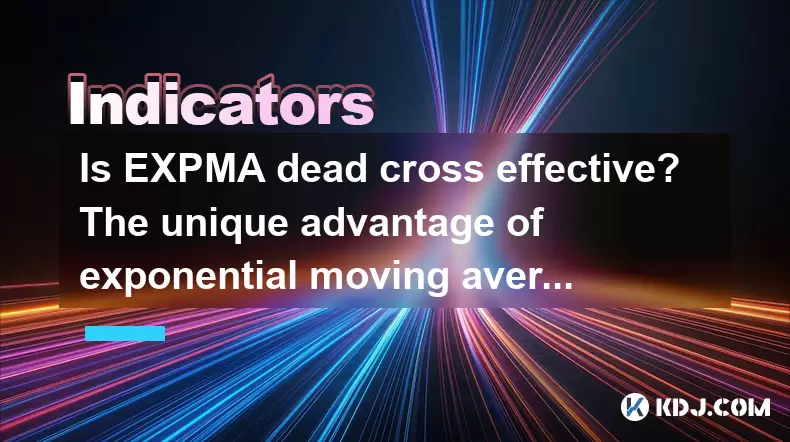
The concept of moving averages, particularly the exponential moving average (EXPMA), plays a crucial role in the analysis of cryptocurrency price movements. Traders often use EXPMA to identify potential trends and make informed trading decisions. One of the key signals that traders watch for is the dead cross, where a short-term EXPMA crosses below a long-term EXPMA. This article will explore the effectiveness of the EXPMA dead cross and delve into the unique advantages that the exponential moving average offers in the realm of cryptocurrency trading.
Understanding the Exponential Moving Average (EXPMA)
The exponential moving average is a type of moving average that places a greater weight and significance on the most recent data points. Unlike the simple moving average (SMA), which assigns equal weight to all values in the period, the EXPMA reacts more quickly to recent price changes. This characteristic makes it particularly useful in the volatile world of cryptocurrencies.
The formula for calculating the EXPMA is as follows:
[ \text{EXPMA}{\text{today}} = (\text{Price}{\text{today}} \times \text{Multiplier}) + (\text{EXPMA}_{\text{yesterday}} \times (1 - \text{Multiplier})) ]
Where the multiplier is calculated as:
[ \text{Multiplier} = \frac{2}{\text{Period} + 1} ]
This formula ensures that the most recent price has a higher impact on the moving average, making it more responsive to recent market movements.
The Concept of the Dead Cross
A dead cross occurs when a shorter-term EXPMA crosses below a longer-term EXPMA. This event is often interpreted as a bearish signal, suggesting that the asset's price may continue to decline. In the context of cryptocurrency trading, a dead cross can be a crucial indicator for traders looking to sell their holdings or enter short positions.
For instance, if a 50-day EXPMA crosses below a 200-day EXPMA, it is considered a significant dead cross. This signal indicates that the short-term trend is now weaker than the long-term trend, potentially signaling the start of a bearish market phase.
Effectiveness of the EXPMA Dead Cross in Cryptocurrency Trading
The effectiveness of the EXPMA dead cross can vary depending on several factors, including market conditions, the specific cryptocurrency being analyzed, and the time frame considered. Here are some key points to consider:
Market Volatility: Cryptocurrencies are known for their high volatility. In such an environment, the EXPMA can provide more timely signals than other moving averages due to its sensitivity to recent price changes. However, this same volatility can also lead to false signals, where the price quickly reverses after a dead cross.
Time Frame: The effectiveness of a dead cross can differ significantly based on the time frame used. For short-term traders, a dead cross on a 15-minute chart may be less reliable than one on a daily chart. Conversely, long-term investors might find dead crosses on weekly or monthly charts to be more indicative of sustained bearish trends.
Confirmation with Other Indicators: To increase the reliability of the EXPMA dead cross, traders often use it in conjunction with other technical indicators such as the Relative Strength Index (RSI), Moving Average Convergence Divergence (MACD), or volume indicators. A dead cross accompanied by high trading volume or other bearish signals can be a more robust indication of a potential downtrend.
Unique Advantages of the Exponential Moving Average
The EXPMA offers several unique advantages that make it a valuable tool for cryptocurrency traders:
Responsiveness: As mentioned earlier, the EXPMA is more responsive to recent price changes than the SMA. This responsiveness is particularly beneficial in the fast-moving cryptocurrency markets, where prices can change dramatically in a short period.
Smoothness: Despite its sensitivity to recent data, the EXPMA still provides a smoother line than other types of moving averages that might react too quickly to price spikes. This balance between sensitivity and smoothness helps traders filter out noise and focus on the underlying trend.
Versatility: The EXPMA can be used across various time frames and in different market conditions. Whether a trader is looking at a 5-minute chart or a weekly chart, the EXPMA can provide valuable insights into the asset's trend.
Combination with Other Tools: The EXPMA can be effectively combined with other technical analysis tools to create a comprehensive trading strategy. For example, traders might use the EXPMA to identify the overall trend and then use the RSI to pinpoint overbought or oversold conditions within that trend.
Practical Application of the EXPMA Dead Cross in Trading
To apply the EXPMA dead cross in your cryptocurrency trading strategy, follow these steps:
Choose Your Time Frame: Decide on the time frame that best suits your trading style. Short-term traders might use a 15-minute or hourly chart, while long-term investors might prefer daily or weekly charts.
Set Up Your EXPMA: Configure your trading platform to display the EXPMA. You will need to set up at least two EXPMA lines: one for the short-term period (e.g., 50 days) and one for the long-term period (e.g., 200 days).
Monitor for the Dead Cross: Keep an eye on your charts to identify when the short-term EXPMA crosses below the long-term EXPMA. This event signals a potential dead cross.
Confirm with Other Indicators: Before acting on the dead cross, look for confirmation from other technical indicators. For instance, if the RSI is also showing overbought conditions, it may reinforce the bearish signal from the dead cross.
Execute Your Trade: Once you have confirmed the dead cross and received additional bearish signals, you can proceed with your trading decision. This might involve selling your holdings or entering a short position.
Set Stop-Loss and Take-Profit Levels: To manage risk, set appropriate stop-loss and take-profit levels. A stop-loss order can help limit potential losses if the market moves against your position, while a take-profit order can secure gains if the price moves in your favor.
Case Studies: EXPMA Dead Cross in Action
To illustrate the effectiveness of the EXPMA dead cross, let's look at a couple of case studies involving popular cryptocurrencies:
Bitcoin (BTC): In early 2022, Bitcoin experienced a significant dead cross when the 50-day EXPMA crossed below the 200-day EXPMA on the daily chart. This event was accompanied by high trading volume and a bearish RSI reading, reinforcing the signal. Following the dead cross, Bitcoin's price continued to decline over the next few months, validating the bearish signal.
Ethereum (ETH): In late 2021, Ethereum also saw a dead cross on its daily chart. The 50-day EXPMA crossed below the 200-day EXPMA, and this was followed by a sharp decline in price. Traders who recognized this signal and acted accordingly were able to avoid significant losses or even profit from short positions.
These case studies demonstrate that, when used correctly and in conjunction with other indicators, the EXPMA dead cross can be an effective tool for identifying potential downtrends in the cryptocurrency market.
Frequently Asked Questions
Q: Can the EXPMA dead cross be used for all cryptocurrencies?
A: While the EXPMA dead cross can be applied to any cryptocurrency, its effectiveness may vary depending on the specific asset's volatility and market conditions. It is generally more reliable for major cryptocurrencies like Bitcoin and Ethereum, which have higher liquidity and more predictable price movements.
Q: How can I avoid false signals when using the EXPMA dead cross?
A: To minimize the risk of false signals, it is crucial to use the EXPMA dead cross in conjunction with other technical indicators. Look for confirmation from indicators such as the RSI, MACD, and volume. Additionally, consider using longer time frames, as these tend to produce more reliable signals.
Q: Is the EXPMA dead cross suitable for beginners?
A: The EXPMA dead cross can be a useful tool for beginners, but it requires a basic understanding of technical analysis. Beginners should start by practicing on a demo account and gradually incorporate the EXPMA dead cross into their trading strategy as they gain more experience.
Q: How often should I check for the EXPMA dead cross?
A: The frequency with which you check for the EXPMA dead cross depends on your trading style and time frame. Short-term traders might need to monitor their charts multiple times a day, while long-term investors can check less frequently, perhaps once a day or even once a week.
Disclaimer:info@kdj.com
The information provided is not trading advice. kdj.com does not assume any responsibility for any investments made based on the information provided in this article. Cryptocurrencies are highly volatile and it is highly recommended that you invest with caution after thorough research!
If you believe that the content used on this website infringes your copyright, please contact us immediately (info@kdj.com) and we will delete it promptly.
- Shiba Inu (SHIB) in the Crypto Landscape: Community, Trends, and Future Outlook
- 2025-08-09 20:30:12
- Lasers in Modern Warfare: Iron Beam and the Future of Defense
- 2025-08-09 20:30:12
- Maxi Doge Presale: The Meme Coin That's Pumping Iron and Prices!
- 2025-08-09 19:10:11
- Rare Coin Warning: Don't Get Fooled by That 1p Coin!
- 2025-08-09 18:50:12
- Cardano, Unilabs, and Tron Price: Decoding the Latest Crypto Buzz
- 2025-08-09 18:30:12
- Aerodrome Finance: Price Targets and the Bullish Channel - What's Next?
- 2025-08-09 18:50:12
Related knowledge

What does it mean when the Triple Moving Average (TRIX) turns downward but the price doesn't fall?
Aug 09,2025 at 12:42pm
Understanding the Triple Moving Average (TRIX) IndicatorThe Triple Moving Average, commonly known as TRIX, is a momentum oscillator designed to filter...

What does it mean when the Williams' oscillator repeatedly hits bottoms but fails to rebound?
Aug 09,2025 at 09:28am
Understanding the Williams %R OscillatorThe Williams %R oscillator, developed by Larry Williams, is a momentum indicator used in technical analysis to...
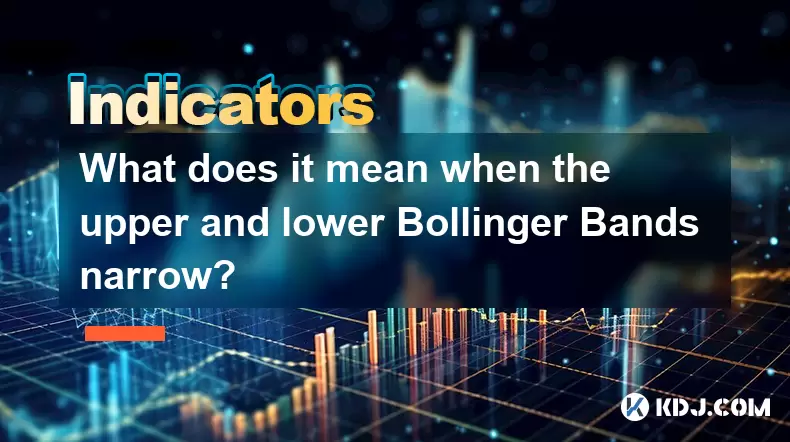
What does it mean when the upper and lower Bollinger Bands narrow?
Aug 09,2025 at 03:00pm
Understanding Bollinger Bands in Cryptocurrency TradingBollinger Bands are a widely used technical analysis tool in the cryptocurrency market, develop...
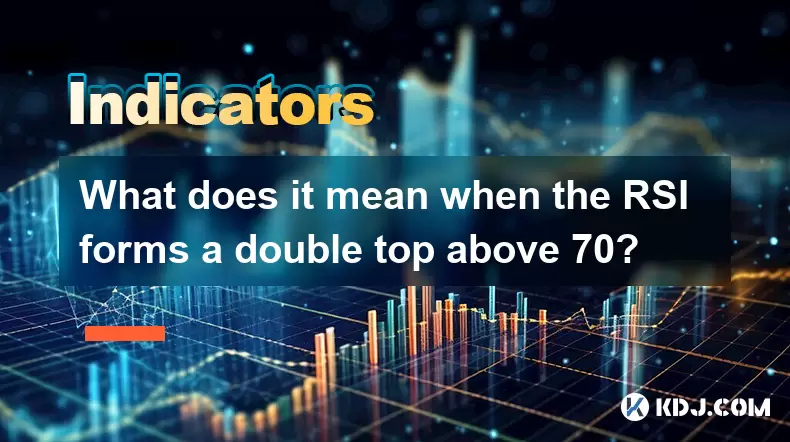
What does it mean when the RSI forms a double top above 70?
Aug 09,2025 at 05:50pm
Understanding the RSI and Overbought ConditionsThe Relative Strength Index (RSI) is a momentum oscillator that measures the speed and change of price ...
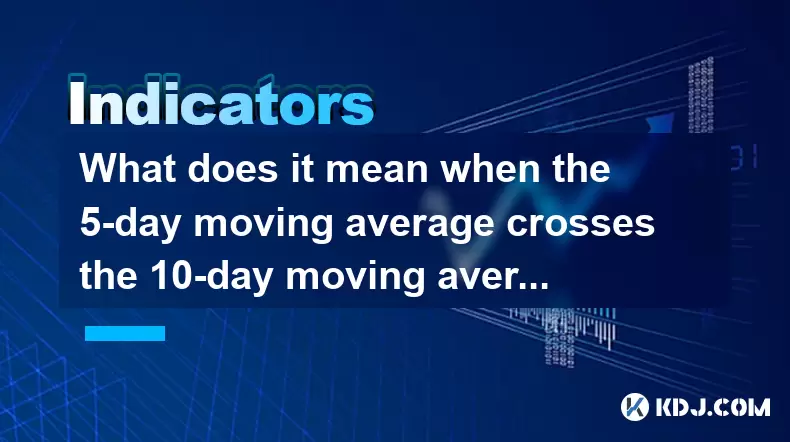
What does it mean when the 5-day moving average crosses the 10-day moving average but the 20-day moving average remains upward?
Aug 09,2025 at 03:35pm
Understanding Moving Averages in Cryptocurrency TradingMoving averages are foundational tools in technical analysis, especially within the cryptocurre...
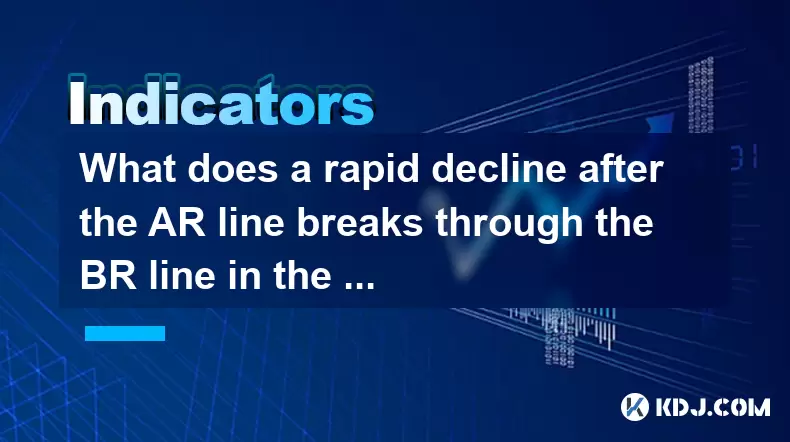
What does a rapid decline after the AR line breaks through the BR line in the ARBR indicator indicate?
Aug 09,2025 at 04:42pm
Understanding the ARBR Indicator ComponentsThe ARBR indicator is a technical analysis tool that combines two oscillators: the AR (Amplitude Ratio) and...

What does it mean when the Triple Moving Average (TRIX) turns downward but the price doesn't fall?
Aug 09,2025 at 12:42pm
Understanding the Triple Moving Average (TRIX) IndicatorThe Triple Moving Average, commonly known as TRIX, is a momentum oscillator designed to filter...

What does it mean when the Williams' oscillator repeatedly hits bottoms but fails to rebound?
Aug 09,2025 at 09:28am
Understanding the Williams %R OscillatorThe Williams %R oscillator, developed by Larry Williams, is a momentum indicator used in technical analysis to...

What does it mean when the upper and lower Bollinger Bands narrow?
Aug 09,2025 at 03:00pm
Understanding Bollinger Bands in Cryptocurrency TradingBollinger Bands are a widely used technical analysis tool in the cryptocurrency market, develop...

What does it mean when the RSI forms a double top above 70?
Aug 09,2025 at 05:50pm
Understanding the RSI and Overbought ConditionsThe Relative Strength Index (RSI) is a momentum oscillator that measures the speed and change of price ...

What does it mean when the 5-day moving average crosses the 10-day moving average but the 20-day moving average remains upward?
Aug 09,2025 at 03:35pm
Understanding Moving Averages in Cryptocurrency TradingMoving averages are foundational tools in technical analysis, especially within the cryptocurre...

What does a rapid decline after the AR line breaks through the BR line in the ARBR indicator indicate?
Aug 09,2025 at 04:42pm
Understanding the ARBR Indicator ComponentsThe ARBR indicator is a technical analysis tool that combines two oscillators: the AR (Amplitude Ratio) and...
See all articles

























































































